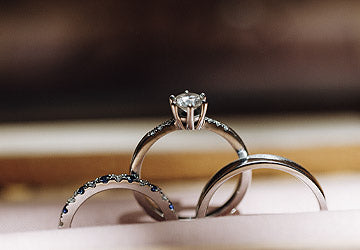The more you learn about diamonds, the more mysterious and alluring these rare crystals become. How are diamonds made and what are they made of? And, where do diamonds come from?
Learn everything you need to know about the origins and formation of diamonds. Find out how diamonds get from deep within the earth, to your wedding ring. And, discover what makes a diamond one of the rarest crystals on earth.
HOW ARE DIAMONDS MADE AND WHAT ARE THESE RARE CRYSTALS MADE OF?
So, how are diamonds made? It is difficult to say for certain how long it takes for diamonds to form under natural conditions. But, what we know, is that diamonds form in the upper mantle of the earth's crust – around a hundred miles beneath your feet.
Humans can’t go that deep into the earth because of the extreme heat and pressure. But, it is exactly this combination of intense heat and high-pressured mineral friction that creates the perfect conditions for diamonds to grow.
But, since humans can’t go a hundred miles down into the earth to see how diamonds form at the outset, scientists can only theorize as to the time it takes diamonds to form inside of the earth. So, how do diamonds get from all the way down in the earth's mantle, to all the way up here where we can mine them out of the surface?
WHERE DO DIAMONDS COME FROM AND HOW DO THEY GET HERE?
To ask, “how are diamonds made?” is to ask, where they are made. But, the question you should be asking, is “when were diamonds made?” Diamonds begin deep in the earth's mantle and are brought to the surface, somehow. Scientists believe that the diamonds which humans have found on the earth's surface were brought up by a volcanic eruption.
Most earth-mined diamonds are deep within the hardened magma on which they traveled. This eruption, likely, occurred hundreds of millions of years ago when the planet was rife with violent and constant volcanic activity. The diamonds which we mine were already formed at the time that they traveled to the surface by way of this volcanic eruption.
Scientists call these diamonds, Kimberlite diamonds – as they come to the surface by the process of the Kimberlite eruption.
This eruption must have been violent, sudden, and short-lived. Diamonds take many years to form in the upper mantle and turn to graphite when subjected to volcanic heat for a prolonged period of time. Since these diamonds exist, it stands to reason that their transport to the surface had to happen in a matter of hours.
WHAT ARE DIAMONDS MADE OF? DIAMONDS AND CARBON
Diamonds are made of carbon atoms, bonded in such a way as to create crystal formations. In high-temperature, high-pressure environments, such as is present in the earth's mantle, carbon atoms bond in a particular formation of five atoms. Each carbon atom naturally forms to four other carbon atoms.
Where the initial carbon comes from is not yet known in mainstream science. Like many things in unexplored places, scientists can only hypothesize as to the origins of the carbon that diamonds are made of. But, this covalent 4-carbon bond structure forms one of the strongest chemical bonds known to the natural world.
The crystalline structure you recognize as a one-carat diamond is a covalent bond of billions and billions of carbon atoms. But, it all starts with four little carbon atoms, and slowly, over hundreds of millions or billions of years, a diamond grows.
HOW OLD ARE EARTH-MINED DIAMONDS YOU SEE TODAY?
The age of the earth is roughly four and a half billion years old. At best guess, scientists believe that diamonds formed in the first couple billion years of the earth's existence. And, though that might provide an idea of the age of a turkey, it doesn't tell you how long it goes in the oven to cook.

Maybe diamonds have to cook in the oven of the earth's upper mantle for a few million, a hundred-million, or billion years to take final form. Or, diamonds might form in a few days, weeks, or months within the earth's mantle – as long as the right conditions are present. A change in geologic conditions might render diamonds dormant for as long as it takes for conditions to change, again.
That being said, modern science and technological advancements have enabled scientists to grow diamonds in laboratory conditions, within a few weeks or months. Granted, the conditions for growth are similar – but not identical to the natural conditions by which earth-mined diamonds form.
For the same reasons that they don’t know the exact age of diamonds, scientists and geologists don’t know for certain if diamonds continue to form in the earth's upper mantle, today. Diamonds might be billions of years old, or just tens of millions – but either way, those turkeys take a long time to cook. It could be that the diamonds that sparkle before you, today, are the only ones that there will ever be on the earth.





